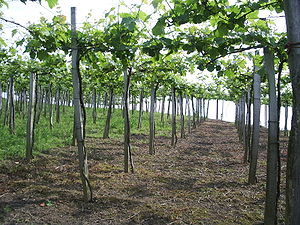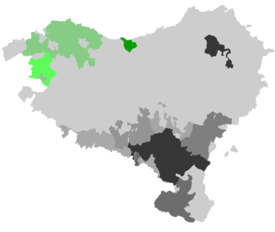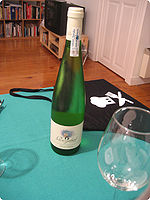
Txakoli
Encyclopedia

Wine
Wine is an alcoholic beverage, made of fermented fruit juice, usually from grapes. The natural chemical balance of grapes lets them ferment without the addition of sugars, acids, enzymes, or other nutrients. Grape wine is produced by fermenting crushed grapes using various types of yeast. Yeast...
with high acidity and low alcohol content produced in the Spanish
Spain
Spain , officially the Kingdom of Spain languages]] under the European Charter for Regional or Minority Languages. In each of these, Spain's official name is as follows:;;;;;;), is a country and member state of the European Union located in southwestern Europe on the Iberian Peninsula...
provinces of the Basque Country, Cantabria
Cantabria
Cantabria is a Spanish historical region and autonomous community with Santander as its capital city. It is bordered on the east by the Basque Autonomous Community , on the south by Castile and León , on the west by the Principality of Asturias, and on the north by the Cantabrian Sea.Cantabria...
and northern Burgos
Burgos
Burgos is a city of northern Spain, historic capital of Castile. It is situated at the edge of the central plateau, with about 178,966 inhabitants in the city proper and another 20,000 in its suburbs. It is the capital of the province of Burgos, in the autonomous community of Castile and León...
. Further afield, Chile
Chile
Chile ,officially the Republic of Chile , is a country in South America occupying a long, narrow coastal strip between the Andes mountains to the east and the Pacific Ocean to the west. It borders Peru to the north, Bolivia to the northeast, Argentina to the east, and the Drake Passage in the far...
is also a producer of chacolí.
It is normally served as an aperitif
Aperitif
Apéritifs and digestifs are alcoholic drinks that are normally served with meals.-Apéritifs:An apéritif is usually served before a meal to stimulate the appetite. This contrasts with digestifs, which are served after a meal for the purpose of aiding digestion...
and drunk within one year of bottling as it cannot be stored for longer. The most common, white, variety has a pale green colour, but there are red and rosé
Rosé
A rosé is a type of wine that has some of the color typical of a red wine, but only enough to turn it pink. The pink color can range from a pale orange to a vivid near-purple, depending on the grapes and wine making techniques.- Production techniques :There are three major ways to produce rosé...
varieties. When served, it is normally poured into tall glasses from a height, often as an accompaniment to pintxos today. It typically has between 9.5-11.5 ABV
ABV
ABV is a three-letter acronym that may refer to:* Alcohol by volume, a measure of the alcohol content of alcoholic drinks* Nnamdi Azikiwe International Airport, Abuja, Nigeria, from its IATA airport code...
.
The 18th century Palace of Mendibile in Leioa
Leioa
Leioa is a municipality in Biscay, Basque Country, in northern Spain. Today it is part of the Bilbao conurbation, and it is the name of a metro station in the Bilbao metro...
near Bilbao
Bilbao
Bilbao ) is a Spanish municipality, capital of the province of Biscay, in the autonomous community of the Basque Country. With a population of 353,187 , it is the largest city of its autonomous community and the tenth largest in Spain...
today houses a museum dedicated to txakoli, the Museo del Txakoli, explaining the history of txakoli and with a large collection of machinery used for making it.
The name
This wine is called txakoli or txakolin(a) in BasqueBasque language
Basque is the ancestral language of the Basque people, who inhabit the Basque Country, a region spanning an area in northeastern Spain and southwestern France. It is spoken by 25.7% of Basques in all territories...
. The word is native Basque, but except for the ending -in which frequently occurs in liquids (cf ozpin "vinegar"), the word is obscure. In Spanish
Spanish language
Spanish , also known as Castilian , is a Romance language in the Ibero-Romance group that evolved from several languages and dialects in central-northern Iberia around the 9th century and gradually spread with the expansion of the Kingdom of Castile into central and southern Iberia during the...
it is commonly spelled chacolí and chacoli in French
French language
French is a Romance language spoken as a first language in France, the Romandy region in Switzerland, Wallonia and Brussels in Belgium, Monaco, the regions of Quebec and Acadia in Canada, and by various communities elsewhere. Second-language speakers of French are distributed throughout many parts...
.
History
Until the 1980s, txakoli was a home-made wine, drunk in the Basque Country, CantabriaCantabria
Cantabria is a Spanish historical region and autonomous community with Santander as its capital city. It is bordered on the east by the Basque Autonomous Community , on the south by Castile and León , on the west by the Principality of Asturias, and on the north by the Cantabrian Sea.Cantabria...
and Valle de Mena
Valle de Mena
The Valley of Mena is a municipality of the province of Burgos, Spain, that borders Biscay.The town has 3,926 inhabitants and the town is under jurisdiction of Villasana de Mena District....
, and almost in danger of dying out towards the middle of the 19th century. However, since some varieties of txakoli in the Basque Country managed to achieve Denominación de Origen
Denominación de Origen
Denominación de Origen is part of a regulatory classification system primarily for Spanish wines but also for other foodstuffs like honey, meats and condiments. In wines it parallels the hierarchical system of France and Italy although Rioja and Sherry preceded the full system...
certification from 1994 onwards, its quality, spread and appeal have increased.
Varieties

Denominación de Origen
Denominación de Origen is part of a regulatory classification system primarily for Spanish wines but also for other foodstuffs like honey, meats and condiments. In wines it parallels the hierarchical system of France and Italy although Rioja and Sherry preceded the full system...
certified varieties.
Most txakoli is grown in the Atlantic regions of the Basque Country, areas with high rainfall (between 1000 mm and 1600 mm of annual rainfall on average) and average temperatures between 7.5 °C and 18.7 °C, occasionally suffering from frost.
Alavan Txakoli
Arabako Txakolina in Basque, Chacolí de Álava in Spanish. This variety comes from the far north-western end of ÁlavaÁlava
Álava is a province of Spain and a historical territory of the Basque Country, heir of the ancient Lord of Álava. Its capital city is Vitoria-Gasteiz which is also the capital of the autonomous community...
. It is the youngest of the three DO varieties of txakoli, having gained certification in 2001. It is yellowish in color, very acidic and slightly frothy.
It is grown over some 55 ha of land around the towns of Aiara, Amurrio
Amurrio
Amurrio is a town and municipality located in the province of Álava, in the Basque Country, northern Spain.-External links:* Information available in Spanish...
, Artziniega, Laudio and Okondo. Wine-making has a long tradition in this region, going back as far as 760 AD in the historical record. In the late 19th century, grapes were grown on more than 500 ha of land, declining to 5ha in the late 20th century before the recent revival.
The most commonly used grape for this txakoli is Hondarribi Zuria ("white Hondarribia
Hondarribia
Hondarribia is a town situated on the west shore of Bidasoa river's mouth, in Gipuzkoa, Basque Country, Spain. The border town is sited on a little promontory facing Hendaye over the Txingudi bay. The town holds an ancient old quarter with walls and a castle...
") but other grapes are also permitted: Bordeleza Zuria (Folle Blanche
Folle Blanche
Folle Blanche was the traditional grape variety of the Cognac and Armagnac regions of France. It is also known as Picpoule as well as Gros Plant and Enrageat Blanc...
), Izkiriota Ttipia (Petit Manseng
Petit Manseng
Petit Manseng is a white wine grape variety that is grown primarily in South West France. It produces the highest quality wine of any grape in the Manseng family. The name is derived from its small, thick skin berries. Coupled with the small yields of the grapevine, most Petit Manseng farmers...
), Izkiriota (Gros Manseng
Gros Manseng
Gros Manseng is a white wine grape variety that is grown primarily in South West France, and is part of the Manseng family. It produces dry wines in the Jurançon and Béarn regions of Southwest France...
) and Courbu
Courbu
Courbu is the name of three different, but related varieties of wine grapes primarily found in South West France. All are Vitis vinifera grapes. The name Courbu, without suffix, can refer to both Petit Courbu and Courbu Blanc, and not all sources differ between the two.- Petit Courbu :Petit Courbu...
.
Biscayan Txakoli

Bizkaiko Txakolina
Txakoli de Bizkaia – Bizkaiko Txakolina is a Spanish Denominación de Origen for wines, located in the province of Bizkaia, Basque Country, Spain...
in Basque, Chacolí de Vizcaya in Spanish. This variety is made in most parts of Biscay
Biscay
Biscay is a province of Spain and a historical territory of the Basque Country, heir of the ancient Lord of Biscay. Its capital city is Bilbao...
, except for the far western end. This was the second txakoli to receive the DO certification in 1994.
It is grown on approximately 150 ha by 85 villages and towns throughout Biscay, producing some 700,000 litres of txakoli annually. Records of wine making in this region go back to the 8th century and references to txakoli go back several centuries themselves. The quality of the txakoli varies, as the microclimatic
Microclimate
A microclimate is a local atmospheric zone where the climate differs from the surrounding area. The term may refer to areas as small as a few square feet or as large as many square miles...
conditions vary.
Both white and red grapes are used for making txakoli in Biscay. White varieties are Hondarribi Zuria and Folle blanche (called Munemahatsa in Biscay); the red variety used is Hondarribi Beltza ("black Hondarribia").
Historically another light red variety called Oilar Begi ("chicken eye") was also used. This variety had almost become extinct and is making a slow comeback.
Txakoli from Getaria

Getaria
Getaria may refer to:* Getaria , a town located in the Basque province of Gipuzkoa* Getaria , a small village in the Basque province of Labourd...
, Zarautz
Zarautz
Zarautz is a coastal town located in the province of Gipuzkoa, in the Basque Country, northern Spain.The town is a popular tourist destination with the population swelling from its usual 22,812 to around 60,000 in summer. The Palace of Narros, located adjacent to Zarautz's 2.8 km long beach,...
and Aia
Aia
Aia is a small village situated on the slopes of Mount Pagoeta in the Basque province of Gipuzkoa, Spain. It is located 30 km to the west of Donostia-San Sebastián and about 10 km inland from the coastal town of Zarautz. Aia is set amongst rolling green hills and lush green forests, and...
and is of a very pale yellow to green color. This was the first variety of txakoli to receive the DO certification in 1989.
Although the cultivated area has increased from 60 ha to 177 ha since certification, this remains the smallest variety in terms of the area cultivated. Annually some 900,000 litres are produced in this area, mostly on south-east facing slopes to protect the vines from the harsh atlantic weather. Unlike the other varieties which are grown as most varieties of grapes, the grapes for this txakoli are grown according to the treille
Treille
Treille or La Treille, French for a grapevine or trellis, may refer to :* La Treille, a Marseille neighborhood* La Treille, Saint Lucia, a town on the island of Saint Lucia in the Caribbean...
or trellis system (called parra in Basque). In this system, the vines are cultivated at a greater height above the ground, with the foliage forming a contiguous canopy to improve the microclimate. The white variety used is Hondarribi Zuria, the red grape is Hondarribi Beltza.
In recent years, other towns in the area have also started growing txakoli grapes, including Orio
Orio
Orio is a fishing town located in the province of Gipuzkoa in the Basque Autonomous Community, northern Spain, with the town nucleus lying on the river Oria, roughly one mile away from its mouth by the Bay of Biscay....
, Zumaia
Zumaia
Zumaia is a small town in the north of Spain in the Basque Country. The Mayor is Iñaki Agirrezabala, member of Eusko Alkartasuna and Gazte Abertzaleak....
, Arrasate, Eibar
Éibar
Eibar is a city and municipality within the province of Gipuzkoa, in the Basque Country of Spain. The city was chartered by Alfonso XI of Castile in 1346...
, Mutriku
Mutriku
Mutriku is a town located in the province of Gipuzkoa in the Autonomous Community of Basque Country in northern Spain. It is the site of the world's first multi-turbine breakwater wave power station, inaugurated July 8, 2011....
, Deba
Deba
- Geography :*Deba, Gipuzkoa, a town in the Basque Country*Deba , a river in the Basque Country*Deba, Nigeria, a town in the Yamaltu/Deba Local Government Area of Gombe State- Other :*Deba bocho, a Japanese type of kitchen knife...
, Zestoa
Zestoa
Zestoa is a town located in the province of Gipuzkoa, in the Autonomous Community of the Basque Country, northern Spain.-External links:* Information available in Spanish and Basque.* Information available in Spanish...
, Hondarribia
Hondarribia
Hondarribia is a town situated on the west shore of Bidasoa river's mouth, in Gipuzkoa, Basque Country, Spain. The border town is sited on a little promontory facing Hendaye over the Txingudi bay. The town holds an ancient old quarter with walls and a castle...
, Villabona
Villabona
Villabona is a village of over 5500 inhabitants in the comarca of Tolosaldea, Gipuzkoa province, Basque Country, Spain. It has a urban area, close to the Oria River, and a rural area, Amasa, around which the village originally formed. Villabona is located in the Oria Valley, in the foothills of...
, Urnieta
Urnieta
Urnieta is a town located in the province of Gipuzkoa, in the Autonomous Community of Basque Country, northern Spain.-External links:* Information available in Spanish and Basque.* Information available in Spanish...
, Oñati
Oñati
Oñati is a town located in the province of Gipuzkoa, in the autonomous community of the Basque Country, in the north of Spain. It has a population of approximately 10,500 and lies in a valley in the center of the Basque country. It lies about 40 km south of the Bay of Biscay and is about 236 m...
, Beizama, Zerain
Zerain
Zerain is a town and municipality located in the Goierri region of the province of Gipuzkoa, in the autonomous community of the Basque Country, northern Spain.-External links:* * *...
and Olaberria
Olaberria
Olaberria is a town and municipality located in the Goierri region of the province of Gipuzkoa, in the autonomous community of the Basque Country, northern Spain.-External links:* *...
.
Cantabrian Chacolí
Chacolí, in the original common French, Spanish and Basque spelling chacoli, was traditional also in the region of CantabriaCantabria
Cantabria is a Spanish historical region and autonomous community with Santander as its capital city. It is bordered on the east by the Basque Autonomous Community , on the south by Castile and León , on the west by the Principality of Asturias, and on the north by the Cantabrian Sea.Cantabria...
until the end of the 19th century. Great amounts were consumed and exported from the 13th to the 19th century, produced in the comarca
Comarca
A comarca is a traditional region or local administrative division found in parts of Spain, Portugal, Panama, Nicaragua, and Brazil. The term is derived from the term marca, meaning a "march, mark", plus the prefix co- meaning "together, jointly".The comarca is known in Aragonese as redolada and...
of Trasmiera
Trasmiera
Trasmiera is a historic comarca of Cantabria , located to the east of the Miera River , reaching the western side of the Asón...
, with villages including Colindres
Colindres
Colindres is a town in the northern Spanish province and autonomous community of Cantabria. Located between the cities of Santander and Bilbao, Colindres has a population of approximately 7200.-Overview:...
, Arnuero
Arnuero
Arnuero is a municipality in the province and autonomous community of Cantabria, northern Spain.The municipality is located in the northeastern portion of the province, and includes three small villages : Arnuero, Soano and Isla...
, Meruelo, Argoños
Argoños
Argoños is a municipality located in the autonomous community of Cantabria, Spain. According to the 2007 census, the city has a population of 1.260 inhabitants.-Towns:*Ancillo*Argoños *Cerecedas*Santiuste-External links:...
and Noja
Noja
Noja is a municipality located in the autonomous community of Cantabria, Spain.It has 2 beaches, "Trengandin" and "Ris"....
as the main vineyards and production areas of chacolí. The production of Cantabria, even in the middle of the 20th century, far exceeded that of the Basque provinces. Chacolí is still produced in Cantabria, but on a very limited scale.
Chacolí from Burgos
It is also still produced in the Valle de MenaValle de Mena
The Valley of Mena is a municipality of the province of Burgos, Spain, that borders Biscay.The town has 3,926 inhabitants and the town is under jurisdiction of Villasana de Mena District....
in the province of Burgos
Burgos
Burgos is a city of northern Spain, historic capital of Castile. It is situated at the edge of the central plateau, with about 178,966 inhabitants in the city proper and another 20,000 in its suburbs. It is the capital of the province of Burgos, in the autonomous community of Castile and León...
, where efforts are being made to receive DO certification.

